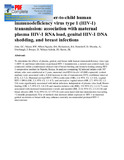Correlates of mother-to-child human immunodeficiency virus type 1 (HIV-1) transmission: association with maternal plasma HIV-1 RNA load, genital HIV-1 DNA shedding, and breast infections
Date
2001Author
John, GC
Nduati, RW
Mbori-Ngacha, DA
Richardson, BA
Panteleeff, D
Mwatha, A
Overbaugh, J
Bwayo, JJ
Ndinya-Achola Jeckoniah O.
Kreiss, JK
Type
ArticleLanguage
enMetadata
Show full item recordAbstract
To determine the effects of plasma, genital, and breast milk human immunodeficiency virus type 1 (HIV-1) and breast infections on perinatal HIV-1 transmission, a nested case-control study was conducted within a randomized clinical trial of breast-feeding and formula feeding among HIV-1-seropositive mothers in Nairobi, Kenya. In analyses comparing 92 infected infants with 187 infants who were uninfected at 2 years, maternal viral RNA levels >43,000 copies/mL (cohort median) were associated with a 4-fold increase in risk of transmission (95% confidence interval [CI], 2.2-7.2). Maternal cervical HIV-1 DNA (odds ratio [OR], 2.4; 95% CI, 1.3-4.4), vaginal HIV-1 DNA (OR, 2.3; 95% CI, 1.1-4.7), and cervical or vaginal ulcers (OR, 2.7; 95% CI, 1.2-5.8) were significantly associated with infant infection, independent of plasma virus load. Breast-feeding (OR, 1.7; 95% CI, 1.0-2.9) and mastitis (relative risk [RR], 3.9; 95% CI, 1.2-12.7) were associated with increased transmission overall, and mastitis (RR, 21.8; 95% CI, 2.3-211.0) and breast abscess (RR, 51.6; 95% CI, 4.7-571.0) were associated with late transmission (occurring >2 months postpartum). Use of methods that decrease infant exposure to HIV-1 in maternal genital secretions or breast milk may enhance currently recommended perinatal HIV-1 interventions
URI
http://www.ncbi.nlm.nih.gov/pubmed/11120927http://erepository.uonbi.ac.ke:8080/xmlui/handle/123456789/16767
Citation
J Infect Dis. 2001 Jan 15;183(2):206-212Publisher
Department of Medicine, University of Washington, Seattle, WA, USA Department of Medical Microbiology, University of Nairobi
Collections
- Faculty of Health Sciences (FHS) [10378]

